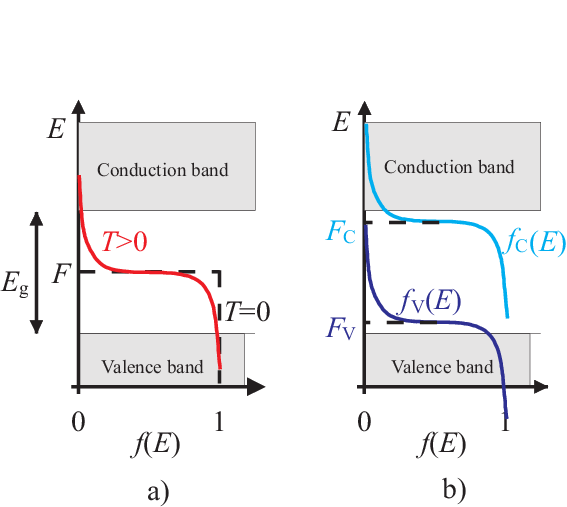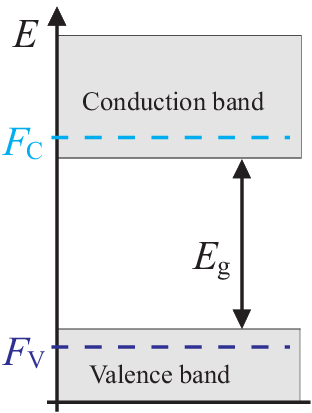|
|
|
|
|
| \begin{equation*} \begin{split} Z_{12}^{(abs)} & = K f(E_1)(1-f(E_2)) \varrho(\omega) \\ Z_{21}^{(ind)} & = K f(E_2)(1-f(E_1)) \varrho(\omega) \end{split} \end{equation*} | (4.24) |
|
| \begin{equation*} Z_{21}^{(ind)} \gt Z_{12}^{(abs)} \qquad . \end{equation*} | (4.25) |
As LASER condition we find consequently
|
| \begin{equation*} f(E_2)(1-f(E_1)) \gt f(E_1)(1-f(E_2)) \qquad . \end{equation*} | (4.26) |
In thermodynamic equilibrium always holds
|
| \begin{equation*} f(E_2) \ll f(E_1) \mbox{ and } (1-f(E_1)) \ll (1-f(E_2)) \qquad . \end{equation*} | (4.27) |
The LASER in action therefor describes a state of extreme non equilibrium.
Description of non equilibrium in a semiconductor
The thermodynamic equilibrium in a semiconductor
is described by the Fermi energy and the temperature dependent shape of the Fermi statistics:
all electrons in all band are in thermal equilibrium
the relative occupation probabilities depend only on the energy differences in the grand canonical ensemble
the time which is necessary to reach the equilibrium depends on the slowest process
the slowest process has the smallest interaction probability

Excitation times:
| Atomic transitions: | \(10^{-15} - 10^{-18} s\) |
| Intra band transitions: | \(10^{-8} - 10^{-12} s\) |
| Band-band transitions: | \(10^{-3} - 10^{-7} s\) |
For one band the chemical potential exists which defines the electron number in this band
Different bands are not in thermal equilibrium
For different bands we need different chemical potentials
Electrons in different bands are handled as distinguishable particles
As for chemical reactions each type of particles has its own chemical potential
The interaction between distinguishable particles is explicitly written as reaction equations
In out case we explicitly name the band-band interactions to describe non equilibrium states
The Fermi statistics for the conduction band is
|
| \begin{equation*} f_C(E) = \frac{1}{\exp\left(\frac{E-F_C}{k T}\right)+1} \end{equation*} | (4.28) |
For the valence band we find
|
| \begin{equation*} f_V(E) = \frac{1}{\exp\left(\frac{E-F_V}{k T}\right)+1} \end{equation*} | (4.29) |
For the LASER condition we get
|
| \begin{equation*} f_C(E_2)(1-f_V(E_1)) \gt f_V(E_1)(1-f_C(E_2)) \qquad , \end{equation*} | (4.30) |
i.e.
This is equivalent to
|
| \begin{equation*} F_C - F_V \gt E_2 - E_1 \geq E_G \qquad . \end{equation*} | (4.32) |

© J. Carstensen (Stat. Meth.)